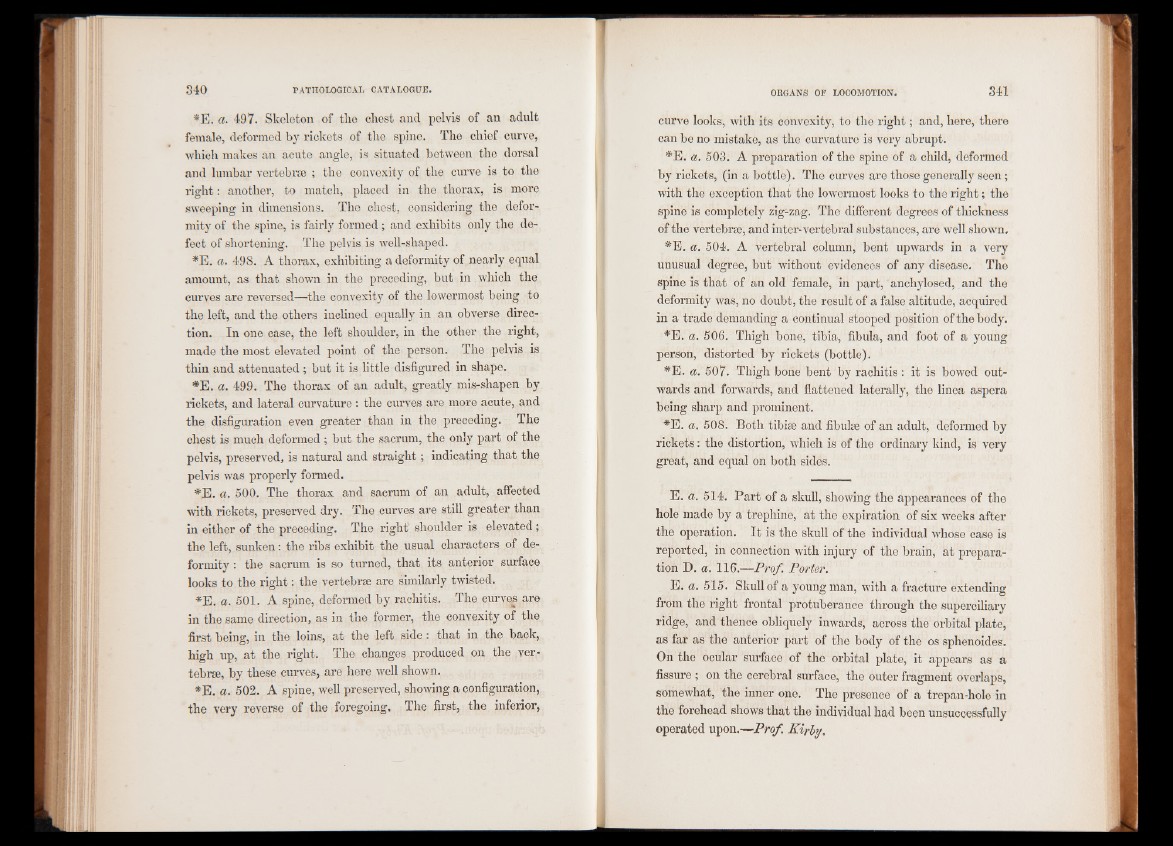
*E. a. 497. Skeleton of the chest and pelvis of an adult
female, deformed by rickets of the spine. The chief curve,
which makes an acute angle, is situated between the dorsal
and lumbar vertebrae ; the convexity of the curve is to the
right: another, to match, placed in the thorax, is more
sweeping in dimensions. The chest, considering the deformity
of the spine, is fairly formed; and exhibits only the defect
of shortening. The pelvis is well-shaped.
*E. a. 498. A thorax, exhibiting a deformity of nearly equal
amount, as that shown in the preceding, but in which the
curves are reversed—the convexity of the lowermost being to
the left, and the others inclined equally in an obverse direction.
In one case, the left shoulder, in the other the right,
made the most elevated point of the person. The pelvis is
thin and attenuated; but it is little disfigured in shape.
#E. a. 499. The thorax of an adult, greatly mis-shapen by
rickets, and lateral curvature : the curves are more acute, and
the disfiguration even greater than in the preceding. The
chest is much deformed ; but the sacrum, the only part of the
pelvis, preserved, is natural and straight; indicating that the
pelvis was properly formed.
*E. a. 500. The thorax and sacrum of an adult, affected
with rickets, preserved dry. The curves are still greater than
in either of the preceding. The right shoulder is elevated;
the left, sunken: the ribs exhibit the usual characters of deformity
: the sacrum is so turned, that its anterior surface
looks to the right: the vertebrae are similarly twisted.
*E. a. 501. A spine, deformed by rachitis. The curves are
in the same direction, as in the former, the convexity of the
first being, in the. loins, at the left side '■ that in the back,
high up, at the right. The changes produced on the vertebrae,
by these curves, are here well shown.
*E. a. 502. A spine, well preserved, showing a configuration,
the very reverse of the foregoing. The first, the inferior,
curve looks, with its convexity, to the right; and, here, there
can be no mistake, as the curvature is very abrupt.
#E. a. 503. A preparation of the spine of a child, deformed
by rickets, (in a bottle). The curves are those generally seen;
with the exception that the lowermost looks to the right; the
spine is completely zig-zag. The different degrees of thickness
of the vertebrae, and inter-vertebral substances, are well shown.
*E. a. 504. A vertebral column, bent upwards in a very
unusual degree, but without evidences of any disease. The
spine is that of an old female, in part, anchylosed, and the
deformity was, no doubt, the result of a false altitude, acquired
in a trade demanding a continual stooped position of the body.
*E. a. 506. Thigh bone, tibia, fibula, and foot of a young
person, distorted by rickets (bottle).
#E. a. 507. Thigh bone bent by rachitis: it is bowed outwards
and forwards, and flattened laterally, the linea aspera
being sharp and prominent.
*E. a. 508. Both tibiae and fibulae of an adult, deformed by
rickets: the distortion, which is of the ordinary kind, is very
great, and equal on both sides.
E. a. 514. Part of a skull, showing the appearances of the
hole made by a trephine, at the expiration of six weeks after
the operation. It is the skull of the individual whose case is
reported, in connection with injury of the brain, at preparation
D. a. 116.—Prof Porter.
E. a. 515. Skull of a young man, with a fracture extending
from the right frontal protuberance through the superciliary
ridge, and thence obliquely inwards, across the orbital plate,
as far as the anterior part of the body of the os sphenoides.
On the ocular surface of the orbital plate, it appears as a
fissure ; on the cerebral surface, the outer fragment overlaps,
somewhat, the inner one. The presence of a trepan-hole in
the forehead shows that the individual had been unsuccessfully
operated upon.—Prof. Kirby.